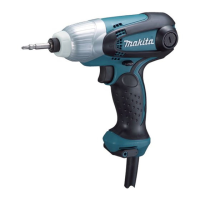2
ENGLISH (Original instructions)
SPECIFICATIONS
Model TD0101/TD0101F
Machine screw 4 mm - 8 mm
Standard bolt 5 mm - 14 mm
Capacities
High tensile bolt 5 mm - 10 mm
No load speed (min
-1
) 0 - 3,600
Impacts per minute (min
-1
) 0 - 3,200
Max. fastening torque 100 N.m
Dimensions (L x W x H) 184 mm x 67 mm x 192 mm
Net weight 0.99 kg
Safety class II
• Due to our continuing programme of research and development, the specifications herein are subject to change without notice.
• Note: Specifications may differ from country to country.
• Weight according to EPTA-Procedure 01/2003
END201-5
Symbols
The following show the symbols used for the equipment.
Be sure that you understand their meaning before use.
읭 Read instruction manual.
읭 DOUBLE INSULATION
읭 Only for EU countries
Do not dispose of electric equipment
together with household waste material!
In observance of European Directive
2002/96/EC on waste electric and
electronic equipment and its
implementation in accordance with
national law, electric equipment that
have reached the end of their life must
be collected separately and returned to
an environmentally compatible recycling
facility.
ENE033-1
Intended use
The tool is intended for screw driving in wood, metal and
plastic.
ENF002-2
Power supply
The tool should be connected only to a power supply of
the same voltage as indicated on the nameplate, and can
only be operated on single-phase AC supply. They are
double-insulated and can, therefore, also be used from
sockets without earth wire.
ENG905-1
Noise
The typical A-weighted noise level determined according
to EN60745:
Model TD0101F
Sound pressure level (L
pA
) : 90 dB(A)
Sound power level (L
WA
) : 101 dB(A)
Uncertainty (K) : 3 dB(A)
Wear ear protection
ENG905-1
Noise
The typical A-weighted noise level determined according
to EN60745:
Model TD0101F
Work mode : impact tightening of fasteners of the
maximum capacity of the tool
Vibration emission (a
h
) : 7.5 m/s
2
Uncertainty (K) : 1.5 m/s
2
ENG901-1
•
The declared vibration emission value has been
measured in accordance with the standard test
method and may be used for comparing one tool
with another.
• The declared vibration emission value may also be
used in a preliminary assessment of exposure.
WARNING:
• The vibration emission during actual use of the
power tool can differ from the declared emission
value depending on the ways in which the tool is
used.
• Be sure to identify safety measures to protect the
operator that are based on an estimation of

